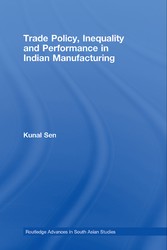
Trade Policy, Inequality And Performance In Indian Manufacturing

von: Kunal Sen
Routledge, 2008
ISBN:
Sprache: Englisch
187 Seiten, Download: 2330 KB
Format: PDF, auch als Online-Lesen
4 Trade policy and economic growth (p. 47-48)
1 Introduction
In the 1980s and 1990s, the Indian economy grew at a rate of 5.8 per cent per annum, considerably higher than the rate of economic growth that was witnessed in the previous decades. At the same time, as we have described in the previous chapter, there was significant trade liberalisation in the 1980s and 1990s in India. Can we explain the higher economic growth observed in the Indian economy since the beginning of the 1980s by pointing to the changes in trade policy that occurred during the same period? In this chapter, we examine the relationship between trade policy and economic growth, paying particular attention to how the trade policy changes may have impacted on the manufacturing sector.
Trade policy can positively impact on economic growth either by increasing the rate of investment or by increasing the efficiency of investment. In this chapter, we focus our attention on the former mechanism. In particular, we examine the relationships between equipment investment and growth, and between the relative price of capital and equipment investment in this chapter.
This is for the following reason. As we have seen in Chapter 2, the major reforms that occurred in the trade regime early on in trade liberalisation process were to do with the liberalisation of capital and intermediate goods imports and less to do with the liberalisation of consumer goods imports. As we will argue in this chapter, liberalisation measures that speci.cally target capital and intermediate goods imports may bring about a fall in the relative price of capital goods. This may lead to an increase in the rate of investment in equipment, and hence in the rate of economic growth, and provide a clear causal mechanism to relate the trade policy changes that occurred in India in the 1980s and 1990s to economic growth. We will, however, examine the e.ect of trade reforms on the efficiency of investment when we study the impact of these reforms on total factor productivity growth and prices in Chapter 5.
The rest of the chapter is divided into five sections. In the next two sections, we set the stage for the empirical analysis by describing the Indian growth experience and then attempting to identify patterns in economic growth and investment behaviour in India during the period of our study. Section 4 presents the conceptual framework that relates the relative price of capital, equipment investment and economic growth. Section 5 discusses the empirical results. Section 6 concludes.
2 Economic growth in India – a brief overview
We begin with a graph of GDP growth (Figure 4.1). As is expected of an economy where climactic factors play an important role in determining total output, output growth shows a great deal of variation from year to year. There is, however, a clear increase in the trend rate of growth of output in the 1980s and 1990s as compared to the earlier period. This is also clear from Table 4.1, where one can see that the high growth rates of the 1980s and 1990s had not been witnessed in the earlier decades, except briefly in the early 1960s.







